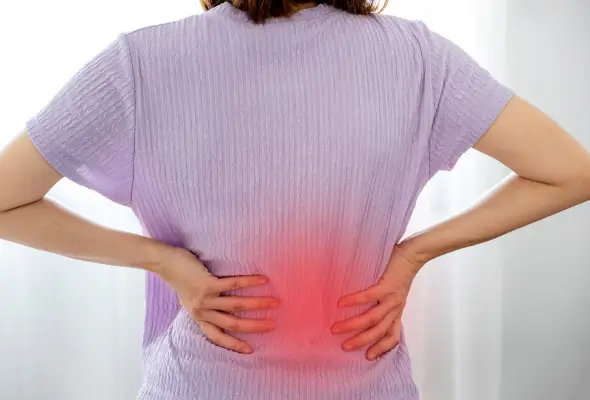-
Doctors
-
Specialities & Treatments
Centre of Excellence
Specialties
Treatments and Procedures
Hospitals & Directions HyderabadCARE Hospitals, Banjara Hills CARE Outpatient Centre, Banjara Hills CARE Hospitals, HITEC City CARE Hospitals, Nampally Gurunanak CARE Hospitals, Musheerabad CARE Hospitals Outpatient Centre, HITEC City CARE Hospitals, Malakpet
HyderabadCARE Hospitals, Banjara Hills CARE Outpatient Centre, Banjara Hills CARE Hospitals, HITEC City CARE Hospitals, Nampally Gurunanak CARE Hospitals, Musheerabad CARE Hospitals Outpatient Centre, HITEC City CARE Hospitals, Malakpet Raipur
Raipur
 Bhubaneswar
Bhubaneswar Visakhapatnam
Visakhapatnam
 Nagpur
Nagpur
 Indore
Indore
 Chh. Sambhajinagar
Chh. SambhajinagarClinics & Medical Centers
Book an AppointmentContact Us
Online Lab Reports
Book an Appointment
Consult Super-Specialist Doctors at CARE Hospitals

Flank Pain
Symptom, Causes, Diagnosis and Treatment
Flank Pain
Have you ever experienced a sharp pain in your side that left you wondering what was wrong? Flank pain can be a troubling symptom that affects many people. This discomfort, which can occur on either the left or right side of the body, often worries people about their health. Understanding flank pain is essential because it can point to various underlying issues that need attention.
Let's explore what flank pain is and why it happens. We'll look at the common symptoms, causes, and associated risk factors of flank pain. You'll also learn about possible complications, how doctors diagnose the problem, and ways to get relief.

What is Flank Pain?
Flank pain is a discomfort that can affect either side of your lower back, between your pelvis and ribs. One can feel this pain as a dull ache or a sharp, stabbing pain. It's usually more intense on one side but can occur on both flanks.
The character of flank pain can be beneficial in determining its cause. Essential characteristics include whether the pain is local or referred, acute or chronic, and its degree of severity and duration. Flank pain can have an impact on your daily life, but it's usually not a cause for immediate concern. Most people experience flank pain at some point in their lives. However, it's advisable to consult a doctor if you have severe flank pain that persists for more than a few days.
Symptoms of Flank Pain
The flank pain symptoms often depend on the underlying cause. The following are some common symptoms of flank pain:
- A sensation of dull ache or sharp pain in the area between their lower ribs and hips
- Flank pain can be localised or radiate to other body parts.
- In some cases, flank pain affects only one side, such as right flank pain or left flank pain. However, it's possible to have pain on both sides simultaneously.
Left-side flank pain or right-side flank pain may have other associated symptoms, depending on the cause. These can include:
- Fever and chills
- Nausea & vomiting (especially if the pain is related to a kidney infection or other urinary tract issues)
- Difficulty moving
- Changes in urination patterns (in kidney problems)
Common Causes and Risk Factors of Flank Pain
- Kidney-related Causes:
- Kidney stones
- Urinary tract infections (UTIs)
- Kidney tumours or other kidney diseases
- Musculoskeletal Causes:
- Muscle strains or injuries in the back, side, or even chest
- Overuse, tension, or maintaining an unusual position for an extended period
- Spinal health issues, such as arthritis or herniated discs, may also cause pain that spreads to the flank area.
- Other Organ-related Causes:
- Gallbladder disease and appendicitis
- Problems with the liver or pancreas can cause pain in the upper right side of the body, which may extend to the flank.
- In rare cases, systemic conditions like diverticulitis or tumours in the retroperitoneal space
- Risk Factors:
- Several factors can increase the likelihood of getting flank pain. These include:
- Dehydration
- A high-sodium diet
- Obesity
- A family history of kidney stones
- People with diabetes are at a higher risk for kidney infections and related complications.
- A sedentary lifestyle
- Frequent engagement in physically stressful activities
Complications
When left untreated, certain conditions causing flank pain may lead to complications significantly impacting a person's well-being.
Kidney problems are a common source of flank pain and can result in severe complications if not addressed promptly. For instance, when an infection spreads from the bladder to the kidneys, it can cause damage to these vital organs. This is why it's crucial for anyone experiencing flank pain along with urinary symptoms to seek medical advice without delay.
In some cases, flank pain may be a symptom of liver or pancreatic conditions. These can become life-threatening if left untreated, although they typically present with other symptoms besides flank pain.
Diagnosis of Flank Pain
- Medical History and Physical Examination: Doctors ask specific questions about your symptoms, such as whether you're experiencing pain on the left flank, right flank pain, or both side flank pain. They'll also inquire about the exact location of the pain, how it changes with different activities and any other symptoms you might be having.
- Basic Metabolic Panel (BMP) Test: This blood test assesses kidney function
- Complete Blood Count (CBC) & Urinalysis: These investigations can detect signs of infection, cancer, or other diseases affecting your organs.
- Imaging/Radiological Tests: A computed tomography (CT) scan or ultrasound can help identify kidney stones and provide information about their size and shape. An X-ray or magnetic resonance imaging (MRI) investigation might be necessary for spine-related issues to reveal detailed images of injuries or abnormalities.
- Cystoscopy: This procedure involves inserting a small tube with a light & camera (the apparatus is called a cystoscope) into the urethra to examine the bladder and lower urinary system.
Treatment for Flank Pain
The approach to treating flank pain depends on its underlying cause.
- Rest and physical therapy often provide relief for minor cases caused by muscle strains.
- Over-the-counter pain medications can help manage discomfort, but it's essential to consult a doctor before taking any medicines, especially if you have kidney problems.
- Antibiotics to treat infections, such as kidney infections or urinary tract infections
- Kidney stones are often treated with increased fluid intake to help pass the stone naturally. A procedure called lithotripsy might be used for larger stones, which uses sound waves to break up the stones for easier passage.
- In cases where flank pain is due to spinal arthritis, doctors may recommend nonsteroidal anti-inflammatory drugs (NSAIDs) and physical therapy.
- For more serious conditions like liver or kidney disease, treatment can range from medication to organ transplantation, depending on the severity.
When to See a Doctor
While flank pain can often be managed by home care, there are situations where medical attention is necessary, such as:
- If the pain doesn't go away after about a day or if it keeps coming back
- If you experience severe or sudden flank pain that makes it hard to carry out your daily activities
- If you've recently had an injury to your side or back and are now experiencing flank pain
Certain symptoms accompanying flank pain warrant immediate medical attention. These include:
- Blood in your urine
- A burning sensation when urinating
- An increased need to urinate.
- High fever and chills
- Nausea or vomiting
- Dizziness
- Headaches
- Skin rash
- For pregnant women experiencing flank pain, it's crucial to seek medical care promptly.
Prevention
While it's not always possible to prevent flank pain, there are several steps you can take to reduce your risk of kidney problems, injuries, and diseases that can cause this discomfort, including:
- Staying hydrated and maintaining good eating habits play a crucial role in lowering your chances of developing kidney stones
- Avoid foods high in sodium, as these can contribute to kidney stone formation
- Maintaining a healthy body weight is among the most critical factors in preventing flank pain.
- Regular physical activity and stretching can help keep your body mass index (BMI) below 30, which reduces your risk of developing kidney stones & puts less pressure on your spine.
- Taking care of your urinary system is essential in preventing infections that can lead to flank pain. If you have a vagina, always wipe from front to back after using the bathroom. It's also advisable to urinate immediately after sexual intercourse and to use the toilet as soon as you feel the urge. Holding your urine increases the chance of developing an infection, resulting in flank pain.
- Stay up to date on vaccinations, including the shingles vaccine, and schedule regular screenings for cancer and other diseases.
Conclusion
Flank pain can significantly impact a person's daily life, ranging from mild discomfort to severe agony. Understanding its causes, symptoms & treatment modalities is crucial for managing this condition effectively. Recognising the signs and seeking timely medical attention can prevent serious complications, whether it's due to kidney issues, musculoskeletal problems, or other underlying health concerns. Taking proactive steps to maintain overall health helps reduce the risk of flank pain. If you or someone you know experience persistent or severe flank pain, consult an expert doctor for proper diagnosis & treatment.
FAQs
1. Where are the flanks located?
The flanks are located on the sides of your body, between your upper abdomen and back. Specifically, they are the areas below the ribs and above the ilium (hip bone). Flank pain can occur on either the left or right side or sometimes both.
2. How common is flank pain?
Flank pain is quite common, with most people experiencing it at least once in their lives. However, the frequency and severity can vary significantly among individuals.
3. Can flank pain be muscular?
Yes, flank pain can often be muscular. Common causes include muscle strains from vigorous exercise, lifting heavy objects, or even prolonged periods of sitting. Muscle tension or stiffness in the flank area can be painful but typically not serious.
4. How long does flank pain last?
The duration of flank pain varies depending on its cause. Rest and home care may resolve Minor muscle strains within a few days. However, if the pain is due to kidney stones or infections, it may persist until the underlying condition is treated.
5. How do you get rid of flank pain?
Treatment for flank pain depends on its cause. Rest, physical therapy & over-the-counter pain medications can help for minor cases. Staying hydrated is crucial, especially for urinary tract-related issues. If the pain is severe and associated with symptoms like fever or blood in urine, consult a doctor for proper diagnosis and treatment.
To Book an Appointment, call:
Still Have a Question?




